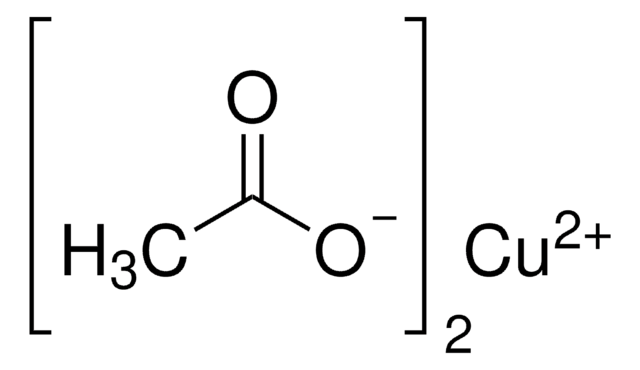Wichtige Dokumente
31232
Eisen(III)-chlorid Hexahydrat
puriss. p.a., reag. Ph. Eur., ≥99%
Synonym(e):
Eisenchlorid
About This Item
Empfohlene Produkte
Agentur
USP/NF
reag. Ph. Eur.
Dampfdruck
1 mmHg ( 194 °C)
Qualität
puriss. p.a.
Assay
≥99%
Form
solid
Verunreinigungen
≤0.001% free chlorine (Cl)
≤0.001% total nitrogen (N)
≤0.05% sub.not precip.b.NH4OH(SO4)
≤0.2% free acid (as HCl)
bp
280-285 °C (lit.)
mp (Schmelzpunkt)
37 °C (lit.)
Anionenspuren
phosphate (PO43-): ≤100 mg/kg
sulfate (SO42-): ≤50 mg/kg
Kationenspuren
As: ≤5 mg/kg
Cu: ≤20 mg/kg
Fe2+: ≤50 mg/kg
Pb: ≤20 mg/kg
Zn: ≤20 mg/kg
SMILES String
O.O.O.O.O.O.Cl[Fe](Cl)Cl
InChI
1S/3ClH.Fe.6H2O/h3*1H;;6*1H2/q;;;+3;;;;;;/p-3
InChIKey
NQXWGWZJXJUMQB-UHFFFAOYSA-K
Suchen Sie nach ähnlichen Produkten? Aufrufen Leitfaden zum Produktvergleich
Verwandte Kategorien
Allgemeine Beschreibung
Anwendung
- Synthesis of 2-substituted 4(3H)-quinazolinones (yield = 77-93%), via condensation of aldehydes with anthranilamide.
- Oxidation of 1,4-dihydropyridines (1,4-DHPs) to corresponding pyridines.
- Oxidation of 4-isopropyl-1,4-DHP to dealkylated pyridine.
Signalwort
Danger
H-Sätze
Gefahreneinstufungen
Acute Tox. 4 Oral - Eye Dam. 1 - Skin Irrit. 2
Lagerklassenschlüssel
11 - Combustible Solids
WGK
WGK 1
Flammpunkt (°F)
Not applicable
Flammpunkt (°C)
Not applicable
Hier finden Sie alle aktuellen Versionen:
Besitzen Sie dieses Produkt bereits?
In der Dokumentenbibliothek finden Sie die Dokumentation zu den Produkten, die Sie kürzlich erworben haben.
Kunden haben sich ebenfalls angesehen
Artikel
Professor Randal Lee (University of Houston, USA) discusses design considerations for iron oxide magnetic nanospheres and nanocubes used for biosensing, including synthetic procedures, size, and shape. The effects of these variables are discussed for various volumetric-based and surface-based detection schemes.
Professor Randal Lee (University of Houston, USA) discusses design considerations for iron oxide magnetic nanospheres and nanocubes used for biosensing, including synthetic procedures, size, and shape. The effects of these variables are discussed for various volumetric-based and surface-based detection schemes.
Unser Team von Wissenschaftlern verfügt über Erfahrung in allen Forschungsbereichen einschließlich Life Science, Materialwissenschaften, chemischer Synthese, Chromatographie, Analytik und vielen mehr..
Setzen Sie sich mit dem technischen Dienst in Verbindung.








